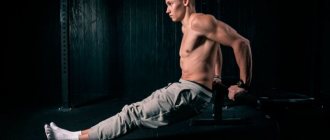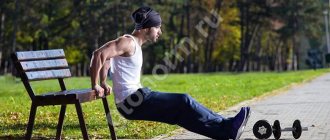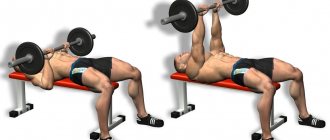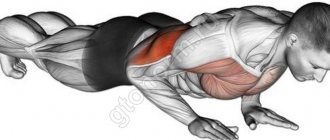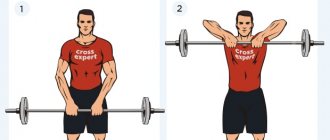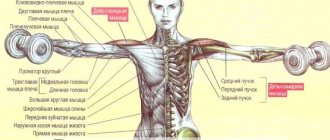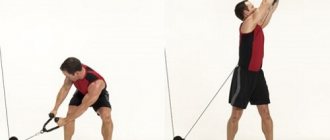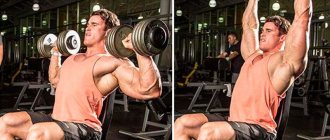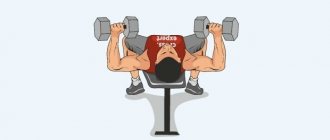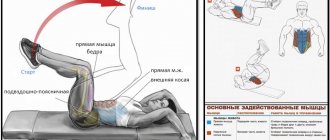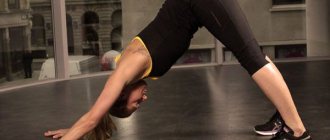There are many exercises for the arms, but most beginner athletes focus on the biceps. It is believed that if this muscle is well developed, the hands look beautiful and impressive. In fact, without pumping up the antagonist muscle - the triceps - the arms are unlikely to look attractive.
The triceps make up 75% of the volume of the entire arm, although it is not very noticeable at first glance. Therefore, he definitely needs to pay attention during the training process. One of the effective exercises that helps tighten and pump up this muscle is reverse push-ups from a bench.
Benefits of reverse push-ups
This exercise is so simple that not only professionals, but also beginners can perform it. Of course, with some adjustments for the level of training.
Beginners are recommended to start triceps training with this exercise. Only after achieving some progress in it, you can take up dumbbells and barbells.
This exercise helps strengthen the joints, ligaments of the hands, tone the muscles, and also strengthen the connection between the muscles and the brain. The latter will allow you to perform more complex exercises with more weight in the future. Only after performing bench push-ups from behind, when you better understand the technique and biomechanics of their implementation, can you move on to the triceps bench press and other exercises that load this muscle. This way you will reduce the risk of injury to your elbow joints or wrists.
Experienced athletes also use this exercise in their training, but with a slightly different goal - to “finish off”, to pump up the triceps with isolated work, so that each of its fascicles is beautifully drawn and stands out. To do this, they perform an exercise at the end of the workout, after which the triceps look advantageous against the background of the developed biceps and deltoids.
Back push-ups are especially useful for women, since they store more fat in the triceps area than men. Hence sagging arms, cellulite and stretch marks.
After menopause, fat usually disappears quickly on this part of women’s arms, leaving stretched, loose skin.
At the same time, women often avoid working with their hands altogether, fearing that they will outrageously increase in volume. In fact, even well-developed arm muscles are not easy for girls to achieve, and exercises with their own weight will never lead to muscle hypertrophy. Therefore, reverse-grip push-ups from a bench are primarily recommended for women.
Bench push-ups: what muscles are involved
Let's figure out which specific muscles work when performing this exercise. First of all, the triceps itself, all its three heads - lateral (which is most noticeable externally), medial and long. The last two are close to the body, so they are not so noticeable.
The main task of the triceps is to straighten the arm at the elbow. The long head, in addition to this work, pulls the arm back, connecting to the muscles of the back and shoulders, and also brings the arm towards the body. Let's look at what other muscles work when doing push-ups, besides the triceps. This exercise engages the abdominal muscles, lower chest, and anterior deltoids.
The exercise helps to develop all three heads of the triceps, to feel the contraction of the muscle and its stretching. The result of correct execution of the exercise will be a triceps in good tone, and if you use weights, it will noticeably increase in volume. If you perform this exercise in combination with the French press, close-grip bench press and other basic exercises, you can achieve good results.
Impact on muscle groups
- Triceps.
- Deltoid muscles.
- Large pectoral muscles.
- Pectoralis minor muscles (Pectinalis minor).
- Diamond-shaped.
- Levator scapulae muscle.
- Vast muscles of the back (Latissimus dorsi).
- Biceps (Biceps brachii)
- Lower trapezius muscle (Trapezius, lower).
Execution options
Bench push-ups from behind the back can be performed in several variations, depending on the athlete’s level of fitness. Beginners are recommended to do this with their feet on the floor, while more advanced athletes place them on a bench installed parallel to the support.
If you are not yet ready to put your feet on the support, complicate the exercise: for each bending of the arms, slightly lift one leg. On the next movement - another. When this becomes easy for you, raise your thigh perpendicular to your body (you can bend your knees). You can also do push-ups at first, moving your pelvis far away from the support.
To increase the load, try to keep your pelvis closer to the support. You can make progress on back bench push-ups by using additional weight. You can place weights on your hips or wear a weighted vest.
When training with your own weight, do about five sets, performing as many reps as possible on each set. Using weights, do an average of 8 reps.
Types of effective exercises
- With your knees bent - an option for beginners. This position allows you to easily control the muscles of the forearms and spine.
- With legs extended forward - a classic option. Straight legs stand hip-width apart with emphasis on the heels.
- Elevated but bent legs are a much more intense form of training. In this exercise, the palms and feet are at the same height.
- With raised straight legs - an option for experienced athletes. Additional weight, such as discs, is often placed on the extended legs. The weight placement is done by your training partner.
The different range of motion allows you to adjust the force load on the triceps.
- Half the amplitude is when the elbows bend at an angle of 45-50 degrees. This exercise option is suitable for beginner athletes.
- Full amplitude is a method for a more advanced level. The movement ends at a right angle at the shoulder joints or even below.
Execution technique
The technique can be performed in three main versions: classic, lightweight (for beginners and overweight people) and advanced (for trained athletes). Variations consist only in different position of the legs and the use of weights.
If the goal of reverse bench push-ups is muscle hypertrophy, you need to use additional weight that can be lifted for 4 to 8 repetitions per set. To do this, you can take weights, dumbbells, put on a special belt with a chain, and at home use a backpack filled with something heavy.
For classic push-ups, you will need two benches of the same height, installed parallel to each other. The distance depends on the length of the trainee's legs. Sitting between the benches, on the one behind, we place our hands approximately shoulder-width apart, palms down. We place the heels on another bench. This exercise can be done at home, leaning on a chair, bed or sofa.
The level of load also depends on the position of the legs. The wider your legs are, the easier it will be to perform the exercise. For maximum load, you can put your legs one behind the other. Also, the closer the benches are, the easier it is to do push-ups. If your foot rests on the bench in your calf area, you will perform more reps than if you press your foot into your heels.
Position yourself between the benches, moving your buttocks closer to the support bench, straighten your back and legs, find a point directly in front of you and hold onto it with your gaze. Begin to slowly bend your elbows and lower your pelvis down, taking a gradual breath. Make sure that your hands go strictly along the body, otherwise you risk injuring your elbow joint. Get low enough to give your triceps a good stretch, but don't try to touch your butt to the floor - this is also dangerous for your joints. Focus on comfort in them. As you exhale, return to the starting position.
About the technique of performing reverse push-ups from a bench.
Having returned to the original position, do not fully extend your arms and immediately go to the next repetition. This way you will relieve your elbow joints from too much stress, and the triceps itself, on the contrary, will be maximally loaded. The fact that reverse push-ups from the bench were beneficial and the technique was correct will be indicated by a strong burning sensation in the muscles.
In beginners, the triceps are usually very weak, and in overweight people they simply cannot withstand the load in the classic version. Therefore, they are recommended to place their feet flat on the floor. This way the center of gravity shifts, and the exercise is much easier to perform. Depending on the preparation of the trainee, the legs can be kept straight or bent at 30°.
For trained athletes, on the contrary, the classic triceps bench push-up will seem insufficient, so it is recommended to use additional weights.
Choose additional weight carefully. Even if the muscles stretch it, the ligaments are not always ready to cope with it.
Most often, a barbell plate is used as a weighting agent. It is more difficult to maintain balance with it, so additional load is placed on the stabilizer muscles. But if the athlete is not yet ready to move to this level, the risk of injury increases.
Main mistakes and contraindications
Using a small range of motion. Incomplete range of motion = incomplete activation of the triceps. Lower yourself all the way down to a 90-degree angle at the elbow joint and rise until your arms are almost straight.
Elbows move in different directions. When performing any triceps exercise, you must keep your elbows close to your sides. If you can't keep your elbows straight, it means the weight is too heavy (you're trying to engage your shoulder muscles to lift yourself up). When the elbows move, the shoulder takes on the bulk of the work, and the load on the biceps is reduced. In addition, if the arms are not fixed, the risk of injury to the shoulder joint is higher. If you find that your elbows are constantly moving apart, reduce the weight and consciously practice pulling your elbows toward the center with each repetition until the position becomes natural.
Unstable support. Instead of focusing on your triceps, you'll have to focus on how to maintain your balance. The exercise is contraindicated for people with shoulder injuries and joint hypermobility syndrome.
How to avoid getting injured: tips and tricks for beginners
Technically, back bench push-ups are a simple exercise with no pitfalls. However, if you want to get the most out of it and protect yourself from possible injuries, you should follow a few tips in its implementation.
First of all, do not perform the exercise if you feel discomfort in the joints of your elbows or shoulders. Cartilage tissue takes a very long time to recover, so it is better to avoid injury to it. If even a lightweight version of push-ups causes inconvenience, it is better to load your triceps on special exercise machines.
Place your hands on the bench strictly at shoulder level. If taken too broadly, they are difficult to control. In this case, you can accidentally bring your elbows inward, risking injury. A long delay in the upper position with straightened elbows is dangerous for injuries. It is better to do as many repetitions as possible without stopping, pumping as much blood into the muscle as possible.
If you have previously had shoulder or elbow injuries, further warm up your muscles and ligaments. If necessary, use elastic bandages. All movements must be performed smoothly, controlled at each phase.
If the triceps are well developed, do not load them with heavy weight in this exercise. It’s better to “kill” it with basic exercises with free weights, and “finish it off” with push-ups at the end of the workout. This way you will achieve better relief.
Dips and bench push-ups have the same biomechanics, so you don’t need to do them on the same training day, otherwise your muscles will be overloaded. Also, do not lean on a soft surface with your hands, otherwise you will have to constantly be distracted by the correct position of your hands.
You should not try to improve this exercise, for example, by doing push-ups with your fists. The best technique for performing it has already been developed for years, and such innovations do not give it any significance. This only increases the risk of injury.
Recommendations
- If you can do your own weight more than 20 times. Then add weights.
- Reverse push-ups are a basic exercise. Therefore, their place is at the beginning of triceps training.
- Don't rush to add weight. For us, the correct execution technique is more of a priority.
- Do not spread your elbows too far to the sides. This will prevent you from loading your triceps properly.
- If, while resting your hands on the bench, you experience pain in the wrist joint. Then turn your brushes slightly inward.
- Avoid jerky movements. Do the exercise smoothly and under control.
- Throughout the entire exercise, your back should be straight.
And most importantly, avoid common mistakes, which are described below.
Contraindications for performing the exercise
You can often come across the opinion that such push-ups are dangerous, so it is not recommended for beginners to do them. Indeed, the exercise requires good stability of the shoulder bag and flexibility of the shoulder joint. If the trainee cannot boast of this, he must bend his arms strictly to an angle of 90° and no more. The weight used should also be moderate. Otherwise, you can injure the weakest part of the deltoid muscle - the rotator cuff.
There is also a danger of injuring the nerve endings of the muscles with a strong dip down. To avoid this, it is recommended to do push-ups on parallel bars, when there is less load on the shoulder joint. But this exercise requires more physical fitness.
The place of the exercise in the overall training program also influences the risk of injury. You should not use it at the end of a workout as a finisher if you are not a trained athlete. By the end of the workout, the shoulder joint is already quite tired and stressed, so there is a high risk of injuring it during concentrated push-ups from the bench.
Reverse triceps push-ups are a great muscle-building exercise. The variety of options for their implementation allows you to include it in the training of both beginners and advanced athletes. Injuries that are sometimes feared about this exercise can be easily prevented by not going too far down, not placing your hands too wide, and using adequate weighting.
Important points
- Do the exercise on one bench without weights for a light workout, or on two benches with weights for maximum gains in muscle size and size.
- If you are doing reverse push-ups on two benches, find the distance between them that makes it most comfortable for you to perform this exercise.
- Keep your body upright throughout the entire approach, without moving your pelvis forward.
- To effectively work your triceps, maintain a constant angle in your knee joints; you do not need to bend and straighten your knees when doing push-ups.
- To avoid injuring your shoulders, don't go too low. If you have problems with your shoulder joints, you should not include this exercise in your training program - you can replace it with regular push-ups with a narrow grip or on parallel bars.
